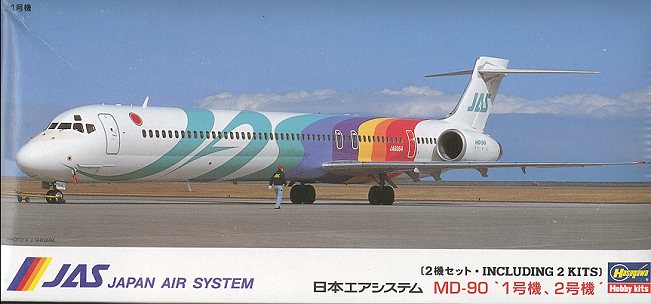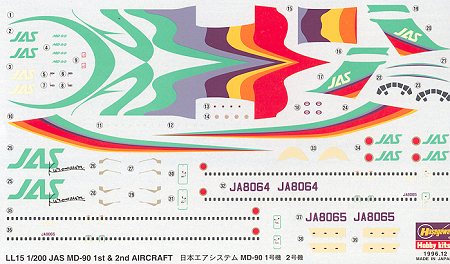
|
KIT: |
Hasegawa 1/200 MD-90 |
|
KIT # |
10215 (LL15) |
|
PRICE: |
@$20.00 |
|
DECALS: |
Japan Air System (JAS) |
|
REVIEW & |
|
|
NOTES: |
'MD-90 1st and 2nd Aircraft' Double kit |

|
HISTORY |
The Douglas DC-9 was one of the more successful of the Douglas twin jet short/medium range airliners ever built. Hundreds of them are still plying the skies of the world providing reliable service. When McDonnell bought out Douglas, the DC-9 nameplate was changed to MD-80 (the MD standing for McDonnell/Douglas). Regardless of what it was named, it was still a DC-9 in heart. As aircraft design improved, mostly in the area of avionics and engines, the DC-9/MD-80 also improved. This resulted in the MD-90 that is currently being flown by a number of the world's airlines.
The MD-90 has a modern 'glass cockpit' and an engine, the V-2500 turbofan, that was developed by a consortium of 50 nations. There are three versions of the MD-90 so far produced. The 114 seat -10, the 153 seat -20 and the 180 seat -30. This kit depicts the MD-90-30 version in its very colorful paint scheme as delivered to Japanese Air System (JAS) for use in domestic service.
|
THE KIT |

Hasegawa has been well-known for its production of 1/200 airliners. These kits are small enough to allow those airliner enthusiasts with limited space the opportunity to get involved in the hobby. Over the years, the kits have been transforming themselves. This is an example of the latest design by Hasegawa. It is actually getting closer to the 'Wooster' type of airliner with few parts and those parts basically snap together.
You will notice in the image above, that the fuselage is now split top and bottom instead of side to side as in 'standard' kits. There are no window holes as most airline builders will fill those in and use decals in their stead. Wings and tailplanes are one piece moldings as are the engine bodies. The landing gear are still like the older kits, however the option of closed gear doors is given where it wasn't before. Previously, the hole for the mounting stand had to be opened in the bottom of the fuselage. Now that hole is permanently there and a plug given for those who do not wish to mount the kit on it's stand. There is also a large nose weight provided for those that wish to display their kit on its landing gear.
 The
decal sheet with this kit is really impressive. It offers two different schemes,
both of them extremely colorful as is the norm with airliner paint jobs
nowadays. The more colorful of the two is illustrated on the box top. As it is
with most Hasegawa printed decals, they are a bit thick, but should be able to
survive the frequent handling that is required to get it just right!
The
decal sheet with this kit is really impressive. It offers two different schemes,
both of them extremely colorful as is the norm with airliner paint jobs
nowadays. The more colorful of the two is illustrated on the box top. As it is
with most Hasegawa printed decals, they are a bit thick, but should be able to
survive the frequent handling that is required to get it just right!
As you can see, the wing walks and anti-glare panels are offered as decals. From looking at the box top, the aircraft is in white, whereas these items are in an ivory color.
I bought my kit on the second-hand market so that is why there are few sprue trees in the kit image.
I look forward to building this kit. Now I need to do some research into possible aftermarket decal sheets for this as I would rather do an US carrier. However, that box top photo is pretty tempting!
Review copy courtesy of me and my wallet!
If you would like your product reviewed fairly and quickly by a site that has over 900 visits a day, please contact me or see other details in the Note to Contributors.